If you are a fan of dim sum or Chinese cuisine, you may have come across a dish called Cheung Fun. With its unique appearance and delectable taste, Cheung Fun has become a popular choice among food enthusiasts around the world. But what exactly is Cheung Fun?
what are rice noodle rolls?
Cheung Fun, also known as rice noodle roll, is a famous traditional snack in Guangdong province, belonging to the Cantonese cuisine. There are two main types of Cheung Fun based on their preparation methods. One is called “Bula Cheung Fun,” which is made by pulling the rice noodle sheets, while the other is steamed directly and is commonly known as “Drawer-style Cheung Fun.”
Cheung Fun is not limited to a specific region because local vendors adjust the flavors according to the local market and cater to the preferences of their customers. As a result, they often incorporate the city’s name into the dish’s title. For example, in Guangzhou, it is called “Guangzhou Xiguan Cheung Fun,” and in Chaozhou, it is known as “Chaozhou Cheung Fun.”
The process of making Cheung Fun involves creating a smooth batter by combining rice flour, water, and a pinch of salt. The batter is then steamed in a rectangular tray, resulting in thin, delicate, and translucent rice noodle sheets. For the “Bula Cheung Fun” variation, the noodle sheets are stretched using a cloth, while the steamed version is directly cut into rolls.
Cheung Fun can be enjoyed with a variety of accompaniments and sauces. One of the most popular ways to serve Cheung Fun is by pairing it with a savory sauce. The sauce typically consists of soy sauce, sesame oil, and sometimes additional flavors from hoisin sauce or oyster sauce. The rice noodle roll is cut into bite-sized pieces and drizzled with the sauce, enhancing its taste.
Cheung Fun also offers a range of filling options to add more depth and texture to the dish. Some common fillings include barbecued pork (Char Siu), shrimp, beef, or vegetables. These fillings are placed on top of the rice noodle sheets before rolling, creating a delightful combination of flavors within each bite.
When it comes to dim sum, Cheung Fun is a must-have dish. Dim sum refers to a Chinese style of brunch or afternoon tea that features a variety of small, bite-sized dishes. Cheung Fun is often served alongside other dim sum favorites such as steamed dumplings, turnip cake, and steamed buns.
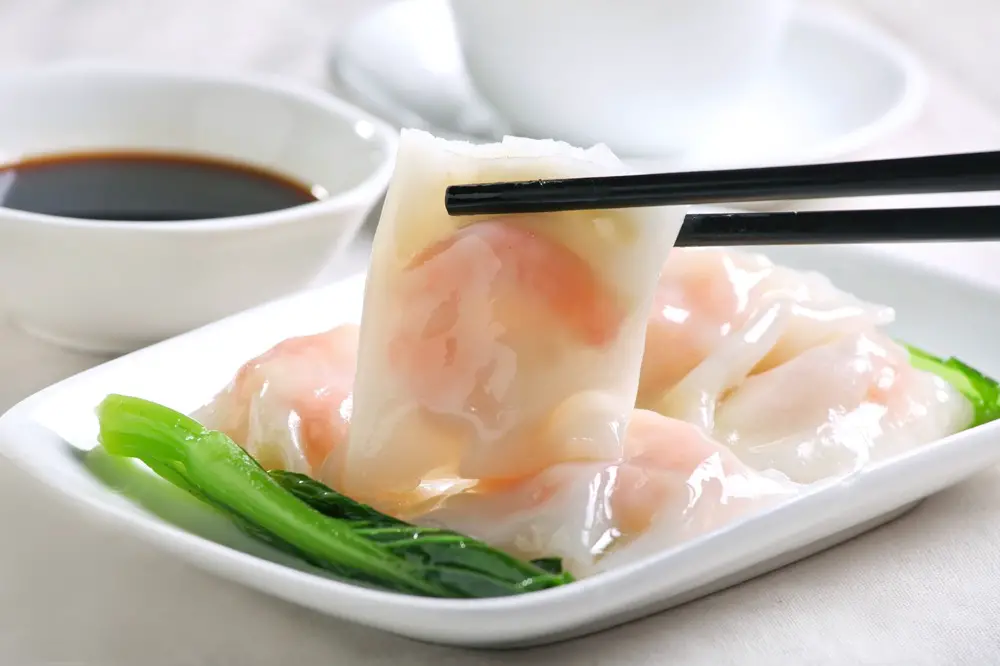
what are cheung fun called?
Cheung Fun, also known as rice noodle roll or Cheong fen, is a distinctive snack and specialty of Guangdong province in China. It is commonly enjoyed as part of morning tea or dim sum, making it a popular dish for breakfast and even late-night snacks. Made from rice flour, Cheung Fun consists of a thin, delicate rice noodle skin wrapped around various fillings, steamed to perfection, and garnished with soy sauce for a burst of flavor.
Often referred to as “pork intestine noodle” due to its resemblance to pig intestines, Cheung Fun is also known by other names such as “pulled noodle” or “rolled noodle.” This versatile dish has become an essential part of Guangdong’s culinary scene and can be found across various dining occasions.
what are rice noodle rolls made of?
The preparation of rice noodle rolls primarily involves creating a rice batter using rice and steaming it to form a translucent rice film. Depending on personal preferences, ingredients such as eggs, shrimp, or pork can be added, and the rolls are then topped with preferred sauce. The process of making rice noodle rolls is relatively simple and requires rice noodle roll pre-mix powder, lean pork, shrimp, eggs, light soy sauce, salt, sugar, cooking wine, and chopped scallions as ingredients.
whar rice noodle rolls come from?
Cheung Fun, originating from Luoding in Guangdong, is one of the famous traditional and distinctive snacks in Guangdong province, China. Cheung Fun is known by various names based on regional distinctions, including Xiguan Cheung Fun in Guangzhou, Puning Cheung Fun, Chaoshan Cheung Fun found in the alleys of Jieyang, Chaoshan Cheung Fun, Hekou Cheung Fun in Yunfu, Hakka Cheung Fun in Meizhou, Doucheng Cheung Fun in Yunan, Chenghai Cheung Fun, Raoping Cheung Fun, and Huilai Cheung Fun.
when was rice noodle rolls invented?
Cheung Fun, or rice noodle rolls, first appeared during the Tang Dynasty and has a history of over a thousand years. Originally known as “Youwei Zi,” it had a much richer and greasier taste compared to the present-day mild flavor. It wasn’t until the reign of Emperor Qianlong in the Qing Dynasty that he learned about Youwei Zi from Ji Xiaolan, who spoke about it with great relish. As a self-proclaimed “food lover,” Emperor Qianlong became curious and accompanied Ji Xiaolan to taste this delicacy in the streets.
During the tasting, Emperor Qianlong couldn’t stop praising this dish. However, he felt that the name was not quite appropriate. Observing its appearance, which resembled pig intestines, he thought “Cheung Fun” would be a more fitting name. After returning to the palace, Emperor Qianlong continued to yearn for this dish. And so, the name and fame of Cheung Fun spread far and wide.
story of rice noodle rolls
During the Tang Dynasty, the Buddhist monks Hui Neng and Hui Ji inadvertently created an oily rice cake known as “youwei ci” in Longzhou (now Luoding City, Guangdong Province). However, the texture of the cake was too thin and couldn’t be divided into individual pieces like before. Instead, it had to be shoveled back together and cut into sections or left uncut. This is the origin of the method used to make rice noodle rolls. At that time, they weren’t called rice noodle rolls yet. To differentiate them from the original oily rice cake, they were referred to as “youwei ci pian” or “oily rice cake slices.”
In an effort to alleviate the disaster caused by the thin rice cake, Hui Ji personally participated in improving the recipe. He arranged for his disciples, including Bao Liang and Hui Neng, to teach the new method to the people of Longzhou. This improved version of the oily rice cake quickly spread across the region. Hui Neng, who was grateful for the opportunity to share this creation, gave it a new name: “Hui Ji Ci” in honor of his fellow monk. Since Hui Ji Ci originated from the Longgan Monastery, it was also known as “Longgan Ci.” Eventually, it became known as “rice noodle rolls,” and the Longgan Monastery in Luoding became the birthplace of rice noodle rolls.
styles of rice noodle rolls
There are two main types of Cheung Fun: Bula Cheung Fun and Drawer-style Cheung Fun. In Guangdong-style morning tea restaurants, Cheung Fun is made to order and not casually sold on carts like other dim sum items. There is a wide variety of Cheung Fun available, including beef Cheung Fun, shrimp Cheung Fun, barbecued pork Cheung Fun, egg Cheung Fun, and more. The Cheung Fun is placed on an oval plate, showcasing its glistening, snow-white appearance, and is often served with a few stalks of vibrant green Guangdong mustard greens, creating a visually appealing and delicious combination, reminiscent of white jade paired with jadeite.
rice noodle roll with shrimp
Rice noodle rolls with shrimp, or shrimp Cheung Fun, are a popular variation of the traditional dish. These rolls feature succulent shrimp as the primary filling, wrapped inside the delicate rice noodle sheets. Shrimp Cheung Fun is a delightful combination of flavors and textures, with the tender shrimp providing a savory and slightly sweet taste that complements the soft and translucent rice noodle skin.
To make shrimp Cheung Fun, the rice noodle sheets are steamed until they become pliable. Fresh shrimp, typically peeled and deveined, are then placed on top of the noodle sheet. The sheet is carefully rolled to enclose the shrimp, creating a cylindrical shape. Finally, the rolls are cut into bite-sized portions and served with a dipping sauce, often a light soy-based mixture, to enhance the overall taste.
Shrimp Cheung Fun is a popular choice among seafood lovers and adds a delectable element to the already delicious rice noodle rolls. The combination of the tender shrimp and the delicate rice noodle skin makes it a favorite option for those seeking a flavorful and satisfying culinary experience.
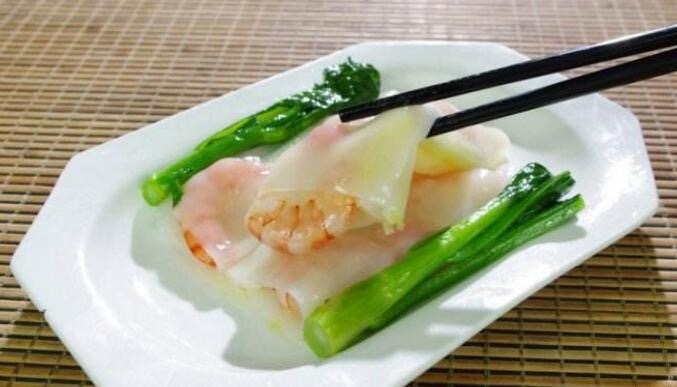
rice noodle roll with dough fritter
Rice noodle rolls with dough fritter, also known as “You Tiao Cheung Fun,” is a delicious and popular variation of the traditional dish. It combines the soft and delicate rice noodle rolls with crispy Chinese dough fritters, creating a delightful contrast of textures and flavors.
To prepare rice noodle rolls with dough fritter, the rice noodle sheets are steamed until they become pliable. Meanwhile, Chinese dough fritters, or “You Tiao,” are deep-fried until golden and crispy. The dough fritters are then placed on top of the rice noodle sheet, and the sheet is carefully rolled around them.
The result is a mouthwatering combination of the soft and slippery rice noodle rolls enveloping the crunchy and savory dough fritters. The contrast between the textures creates a delightful eating experience. To enhance the flavors, a dipping sauce is often served alongside, such as soy sauce or a sweet and savory hoisin-based sauce.
Rice noodle rolls with dough fritter are a popular choice for breakfast or as a snack throughout the day. The combination of rice noodles and dough fritters provides a satisfying and fulfilling meal, with the different textures and flavors coming together to create a unique culinary delight.
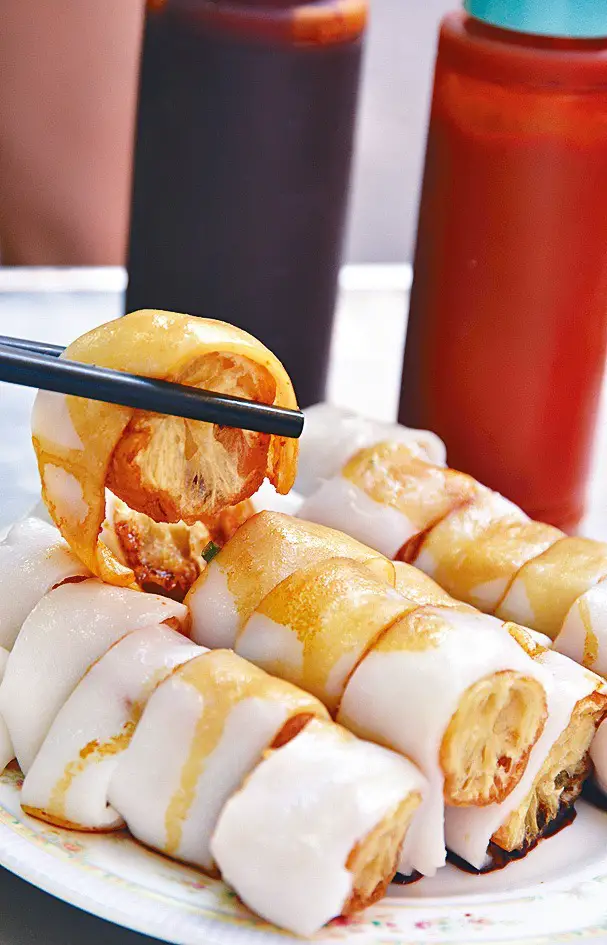
rice noodle roll with rice paper
Rice noodle rolls with rice paper, also known as “Banh Cuon” in Vietnamese cuisine, is a delightful variation of the traditional dish. This version incorporates the use of thin and translucent rice paper sheets to encase the rice noodles, resulting in a lighter and slightly different texture.
To create rice noodle rolls with rice paper, the rice paper sheets are briefly soaked in warm water to soften them. Then, cooked rice noodles are spread evenly on top of the moistened rice paper. Additional fillings such as minced pork, mushrooms, and shallots can be added to enhance the flavor and texture.
Once the fillings are added, the rice paper is carefully rolled into a cylindrical shape, similar to a spring roll. The rolls are then steamed to perfection, allowing the flavors to meld together and the rice paper to become tender and cohesive.
Rice noodle rolls with rice paper are typically served with a dipping sauce that combines savory and tangy flavors. The sauce may include ingredients such as fish sauce, lime juice, garlic, chili, and sugar, creating a perfect balance of sweet, salty, sour, and spicy tastes.
This variation of rice noodle rolls offers a lighter and more delicate experience, with the rice paper adding a unique texture and subtly different flavor. It is a popular choice in Vietnamese cuisine, enjoyed as a main dish or as part of a larger spread of Vietnamese street food.
rice noodle roll with peanut sauce
Rice noodle rolls with peanut sauce is a delightful combination that adds a rich and creamy flavor to the traditional dish. The smooth and velvety peanut sauce complements the soft and translucent rice noodle rolls, creating a harmonious blend of textures and tastes.
To prepare rice noodle rolls with peanut sauce, the rice noodle sheets are steamed until they become pliable. The sheets are then filled with a choice of ingredients such as shrimp, vegetables, or tofu, creating a flavorful filling within the rolls.
The peanut sauce is made by combining peanut butter, soy sauce, hoisin sauce, sesame oil, garlic, and other seasonings. The sauce is typically creamy and slightly sweet, with a hint of nuttiness. It can be adjusted to personal taste preferences by adding ingredients like chili paste or lime juice for an extra kick of flavor.
To serve, the rice noodle rolls are drizzled with the peanut sauce or dipped into it. The creamy and savory peanut sauce pairs perfectly with the delicate rice noodle rolls, providing a satisfying and indulgent experience.
Rice noodle rolls with peanut sauce are popular in various Asian cuisines, including Thai and Vietnamese cuisine. The combination of the soft rice noodle rolls and the luscious peanut sauce creates a delightful harmony of flavors that is sure to please your taste buds.
what is the cheung fun symbolizes?
- The symbolism of men and women eating rice noodle rolls represents the blending and integration of genders, symbolizing their interdependence and ultimate unity. It is often seen as a warm and joyful symbol, expressing a shared hope and wish for a meaningful and prosperous life and a better future.
- In the southern regions of China, rice noodle rolls are a common breakfast dish. The word “Cheung” in Cantonese, which means “intestine,” sounds similar to the word for “prosperity” and “abundance.” Therefore, rice noodle rolls have become a traditional food during the New Year, symbolizing the wish for prosperity and abundance.
- During the process of making rice noodle rolls, the rice batter is steamed to form soft rice noodle sheets, which are then filled with aromatic ingredients. When you take a bite, the delicate rice noodle skin bursts open, releasing the flavors of the filling. This experience evokes a beautiful vision of the New Year: the hope that, like rice noodle rolls, one can be soft yet resilient, savoring the deliciousness while overcoming challenges and embracing opportunities.
- Furthermore, rice noodle rolls carry different cultural symbols in various regions. In Guangdong, they are considered a symbol of good feng shui, and it is believed that walking three rounds in front of a rice noodle roll stall can bring good luck to businesses. In Hunan, rice noodle rolls symbolize “prosperous business” because their pronunciation is similar to the phrase “Chinese businesses thrive in Chinatown.”
cheung fun in Buddhism
According to legend, rice noodle rolls are believed to have originated during the Tang Dynasty when Master Huineng, the sixth patriarch of Zen Buddhism, came to Lingnan (present-day Guangdong) to spread Buddhist teachings. He developed a fondness for a local snack called “youwei ci,” which eventually evolved into rice noodle rolls.
According to historical records, rice noodle rolls first appeared in Longzhou, a city in the Tang Dynasty (now known as Luoding, Guangdong). It was derived from a traditional local delicacy called “longkan ci.” The invention of this dish was accidental and attributed to a Buddhist practitioner at the Longkan Monastery. Initially, the practitioner combined rice batter with oil, salt, crushed peanuts, scallions, and chives, steaming them into a semi-thick rice cake, convenient for immediate consumption. Due to its quick preparation, simple ingredients, refreshing taste, and delicate and smooth texture, the longkan ci gained popularity in Longzhou and was passed down through generations.
In Buddhism, “Cheung Fun” refers to a type of food known as rice noodle rolls or rice crepes. While there is no specific religious or spiritual significance attached to Cheung Fun in Buddhist teachings, it is consumed by people of different backgrounds and religious beliefs, including Buddhists.
Buddhism emphasizes mindfulness, compassion, and the practice of non-violence towards all sentient beings. As such, Buddhists often follow a vegetarian or vegan diet, abstaining from consuming meat or other animal products. Cheung Fun can be a suitable food option for Buddhists who adhere to a plant-based diet since it can be prepared with various vegetarian fillings such as vegetables, tofu, or mushrooms.
Food, including Cheung Fun, is generally viewed in Buddhism as sustenance for the body rather than having intrinsic spiritual or religious significance. However, Buddhists may approach their meals with mindfulness and gratitude, recognizing the interconnectedness of all beings and the impact of their food choices on the world around them.
cheung fun in Taoism
In Taoism, “Cheung Fun” does not have any specific spiritual or symbolic significance within the religious teachings. Taoism is a philosophical and spiritual tradition that emphasizes harmony with nature, balance, and the cultivation of the Tao, or the Way.
Food in Taoism is often approached from a perspective of balance and harmony with nature. The focus is on consuming natural and unprocessed foods that promote health and vitality. While Cheung Fun can be enjoyed as part of a balanced diet, it does not hold any particular spiritual significance within Taoism.
Taoist dietary principles generally promote a plant-based diet that includes a variety of fruits, vegetables, grains, and legumes. This is in line with the belief in the interconnectedness of all living beings and the importance of respecting and preserving the natural world.
In Taoism, the emphasis is more on spiritual practices such as meditation, energy cultivation, and living in accordance with the principles of the Tao. Food is viewed as a means to nourish and sustain the body, but it is not considered a central aspect of Taoist spirituality or practice.
cheung fun in Chinese medical
Function and Benefits of Rice Noodle Rolls: Rice noodle rolls originated in Guangdong and are known for their translucent appearance and sticky texture. They offer various health benefits, including nutritional supplementation, nourishing the spleen, promoting lung health, and aiding in weight loss.
Nutritional Supplementation: Rice noodle rolls provide a rich source of vitamins, dietary fiber, proteins, and anthocyanins. They also contribute to skincare by replenishing moisture and improving skin elasticity.
Nourishing the Spleen and Enhancing Qi: The main ingredient, rice batter, nourishes the spleen, harmonizes the stomach, and clears the lungs. It helps invigorate Qi, strengthen the spleen and stomach, nourish Yin, moisten the lungs, and alleviate restlessness and thirst.
Alleviating Lung Yin Deficiency: Rice noodle rolls are effective in relieving symptoms associated with lung Yin deficiency, such as cough and constipation.
Weight Loss: As rice noodle rolls primarily consist of starch, they can promote a feeling of fullness, reducing the consumption of other foods and aiding in weight loss. They provide essential energy while preventing excessive food intake.
Precautions:
- Suitable for individuals with physical weakness, weak spleen and stomach, and lung Yin deficiency.
- Unsuitable for individuals with high cholesterol levels or allergies to eggs.
- It is not recommended to consume rice noodle rolls together with honey, as it may cause stomach discomfort.
- Avoid combining rice noodle rolls with ferns, as it may impair the digestion and absorption of vitamin B1.
- Please note that the translation provided is for informational purposes and it’s always recommended to consult with a healthcare professional or nutritionist for personalized advice.
how to make rice noodle rolls?
Ingredients:
Rice Batter:
10g (adjust according to personal preference)
500g rice
Sauce:
2 tablespoons soy sauce
1 tablespoon oyster sauce
10g cornstarch
10g minced garlic (adjust according to personal preference)
10g diced onions (adjust according to personal preference)
1 tablespoon vegetable oil
1 tablespoon chicken powder
Fillings:
10g assorted vegetables (adjust according to personal preference)
2 eggs
20g chopped green onions
10g bacon (adjust according to personal preference)
2 sausage links
10g lettuce (adjust according to personal preference)
Instructions:
- Soak the rice overnight. This step is essential, so make sure to soak the rice the night before.
- Rinse and drain the rice. Weigh the rice and add an equal amount of water. For example, if you have 500g of rice, add 650g of water. Place the rice and water in a blender and blend on the juice setting, repeating the process twice.
- Fill a pot with water and place a 4-inch cake mold inside. The water should reach a boiling point with the lid on.
- Grease a pizza pan or any flat-bottomed pan. I used a 10-inch pizza pan, but you can use any similar pan. Spread a thin layer of rice batter on the bottom of the pan (stir the settled rice batter at the bottom with a spoon to mix it well). Add the egg mixture, chopped green onions, and any other desired fillings.
- The water in the pot should be boiling. Place the pan inside the pot and cover it with a lid. Steam on high heat for approximately 2-3 minutes, until large bubbles form. Steam until fully cooked, but be careful not to overcook.
- Remove the pan from the pot using tongs and scrape the rice noodle roll onto a plate.
- To make the sauce, bring a pot of water to a boil. Add minced onions and cook for 2 minutes. Then add soy sauce, oyster sauce, salt, and chicken powder to season. In a separate small bowl, mix cornstarch with cold water and add it to the boiling sauce, stirring until thickened. Finally, add minced garlic and cook for another 2 minutes. The sauce is ready. If desired, add chili sauce for a spicy flavor.
- Pour the sauce over the rice noodle roll. The dish is now ready to be served.
rice noodle rolls vs rice noodles
Rice Noodle Rolls and Rice Noodles are both popular dishes made from rice, but they have some key differences:
Shape and Texture: Rice Noodle Rolls, also known as Cheung Fun, are thin sheets of steamed rice batter that are rolled up into a cylindrical shape. They have a smooth and slightly chewy texture. Rice noodles, on the other hand, are long, thin strands made from rice flour and water. They are flexible and have a softer texture.
Preparation Method: Rice Noodle Rolls are made by steaming a thin layer of rice batter until it solidifies into a translucent sheet. The sheet is then rolled up and cut into smaller pieces. Rice noodles are made by mixing rice flour and water into a dough, which is then extruded or rolled out into thin strands. These strands are typically boiled or stir-fried before being used in dishes.
Usage: Rice Noodle Rolls are commonly used as a wrapper for fillings such as shrimp, beef, or vegetables. They are often served with a savory sauce or soy sauce. Rice noodles, on the other hand, are versatile and can be used in a variety of dishes. They are commonly found in soups, stir-fries, salads, and noodle dishes like Pad Thai or Pho.
Serving Style: Rice Noodle Rolls are usually served as a dim sum dish or as a street food snack. They are often steamed and served with a dipping sauce. Rice noodles, on the other hand, can be served hot or cold, depending on the dish. They are often mixed with other ingredients or served in a broth.
In summary, while both Rice Noodle Rolls and Rice Noodles are made from rice, they have different shapes, textures, preparation methods, and serving styles. Rice Noodle Rolls are rolled-up sheets of steamed rice batter, while Rice Noodles are long, thin strands. They are used in different ways and have different culinary applications.
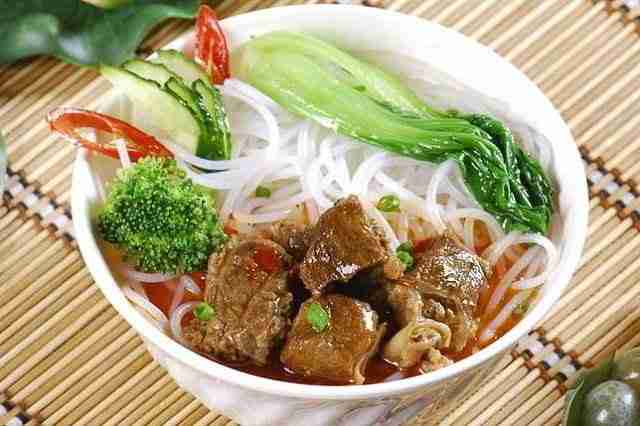
rice noodle roll vs spring roll
Rice Noodle Roll:
Rice noodle roll, also known as cheung fun, is a popular dish in Cantonese cuisine.
It is made by steaming a thin sheet of rice noodle batter and then rolling it around various fillings.
The fillings can include ingredients like shrimp, beef, char siu (barbecue pork), or vegetables.
Rice noodle rolls are typically served with a light soy sauce or peanut sauce for dipping.
They have a soft, smooth texture and are often enjoyed as a dim sum dish or for breakfast.
Spring Roll:
Spring roll is a type of fried or fresh roll commonly found in various Asian cuisines.
It typically consists of a thin pastry wrapper filled with a mixture of vegetables, meat, or seafood.
The fillings can vary widely, including ingredients like shredded cabbage, carrots, bean sprouts, mushrooms, shrimp, or chicken.
Spring rolls are often deep-fried until crispy, resulting in a crunchy texture, or they can be served fresh without frying.
They are commonly served with dipping sauces such as sweet and sour sauce or plum sauce.
In summary, while both rice noodle rolls and spring rolls involve rolling ingredients in a wrapper, they differ in terms of the wrapper used, cooking method (steaming for rice noodle rolls vs. frying or fresh for spring rolls), and fillings. Rice noodle rolls are typically made with a steamed rice noodle wrapper and filled with various ingredients, while spring rolls use a pastry wrapper and can be either fried or served fresh with a variety of fillings.
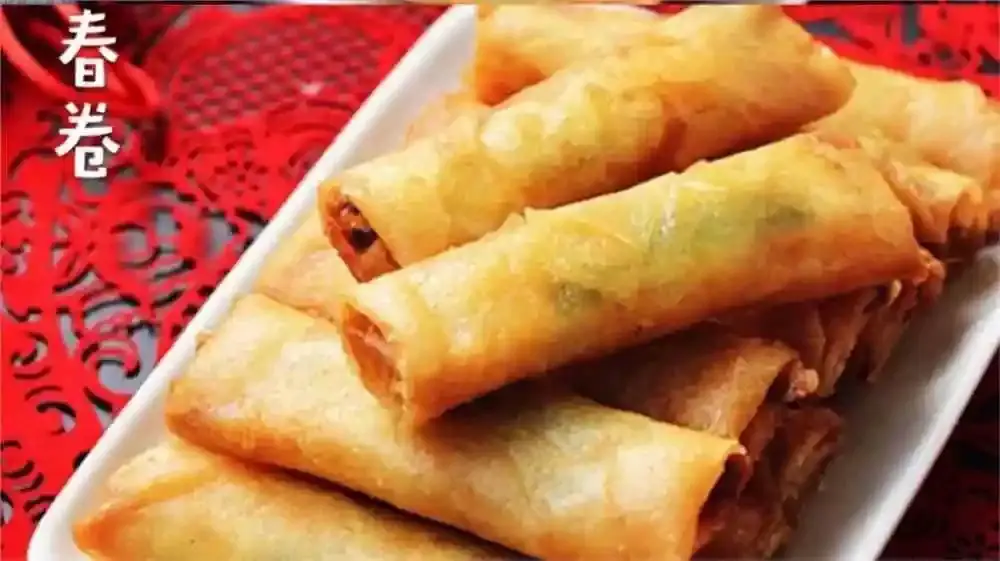
rice noodle roll vs egg roll
Rice Noodle Roll:
Rice noodle roll, also known as cheung fun, is a dish commonly found in Cantonese cuisine.
It is made by steaming a thin sheet of rice noodle batter and then rolling it around various fillings.
The fillings can include ingredients like shrimp, beef, char siu (barbecue pork), or vegetables.
Rice noodle rolls are typically served with a light soy sauce or peanut sauce for dipping.
They have a soft, smooth texture and are often enjoyed as a dim sum dish or for breakfast.
Egg Roll:
Egg roll is a popular fried appetizer commonly found in Chinese and American Chinese cuisine.
It typically consists of a wheat-based wrapper filled with a mixture of vegetables, meat, and sometimes noodles.
The fillings can include ingredients like cabbage, carrots, bean sprouts, onions, and often diced pork or shrimp.
Egg rolls are deep-fried until crispy, resulting in a crunchy exterior and a savory filling.
They are commonly served with sweet and sour sauce or other dipping sauces.
In summary, rice noodle rolls and egg rolls are different in terms of their wrappers, cooking methods (steaming for rice noodle rolls vs. deep-frying for egg rolls), and fillings. Rice noodle rolls use a steamed rice noodle wrapper and are filled with various ingredients, while egg rolls use a wheat-based wrapper and are filled with a mixture of vegetables, meat, and sometimes noodles before being deep-fried.
rice noodle roll vs jianbing
Rice Noodle Roll:
- Rice noodle roll, also known as cheung fun, is a popular dish in Cantonese cuisine.
- It is made by steaming a thin sheet of rice noodle batter and then rolling it around various fillings.
- The fillings can include ingredients like shrimp, beef, char siu (barbecue pork), or vegetables.
- Rice noodle rolls are typically served with a light soy sauce or peanut sauce for dipping.
- They have a soft, smooth texture and are often enjoyed as a dim sum dish or for breakfast.
- Jianbing is a traditional Chinese street food and breakfast item.
- It is a thin and crispy crepe-like pancake made from a batter primarily consisting of mung bean and wheat flour.
- The batter is spread onto a griddle or flat pan and topped with ingredients such as egg, scallions, cilantro, and sauces like hoisin sauce or chili sauce.
- Jianbing is often filled with additional ingredients like pickled vegetables, crispy fried wonton skins, or Chinese-style crullers (youtiao).
- Once the toppings are added, the jianbing is folded and can be eaten on the go.
In summary, rice noodle rolls and jianbing are both popular Chinese dishes, but they differ in their preparation and ingredients. Rice noodle rolls are made with steamed rice noodle sheets rolled around various fillings, while jianbing is a thin and crispy pancake filled with ingredients and folded for easy consumption.
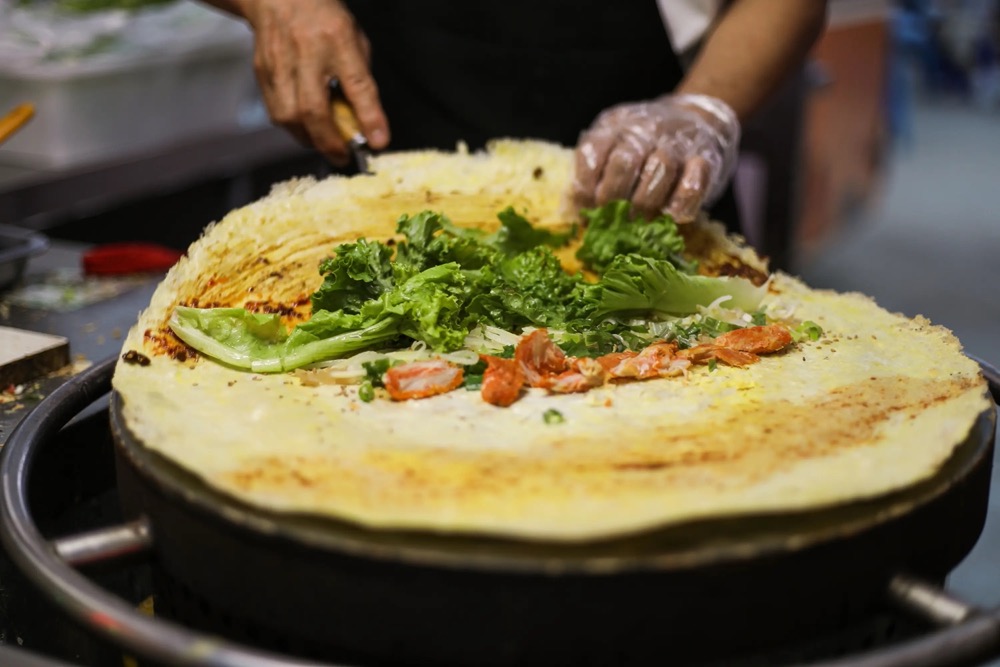
is cheung fun healthy
Cheung fun, or rice noodle rolls, can be a healthy food choice depending on the specific ingredients and preparation methods used. Here are some factors to consider:
Nutritional Content: Rice noodle rolls are primarily made from rice flour, which is a good source of carbohydrates. They are generally low in fat and cholesterol-free. However, the overall nutritional content can vary based on the fillings and sauces used. Opting for lean protein options like shrimp or vegetables can enhance the nutritional value.
Fiber: Rice noodle rolls may not be a significant source of dietary fiber unless they contain additional fiber-rich ingredients like vegetables or bean sprouts. Including fiber in your meal can promote better digestion and help with satiety.
Sodium Content: The sodium content of rice noodle rolls can vary depending on the sauces and condiments used. Soy sauce and other dipping sauces can be high in sodium. Choosing lower-sodium options or consuming them in moderation can help reduce sodium intake.
Cooking Methods: Steaming is the traditional cooking method for rice noodle rolls, which helps retain more nutrients compared to deep-frying. Steamed versions are generally considered a healthier option.
Portion Size: Controlling portion sizes is essential for maintaining a balanced diet. Rice noodle rolls are often served as part of a dim sum meal or street food platter. Be mindful of portion sizes and try to balance them with other nutritious foods.
It’s worth noting that individual dietary needs and preferences may vary. If you have specific dietary concerns or restrictions, it’s advisable to consult with a healthcare professional or nutritionist for personalized advice.
rice noodle roll calories
The calorie content of rice noodle rolls can vary depending on the specific recipe, fillings, and sauces used. Here is a general estimation of the calorie content in a plain rice noodle roll:
On average, a plain rice noodle roll without any fillings or sauces can contain approximately 80-100 calories per roll. This estimate is based on a typical serving size of one roll, which is about 30 grams.
However, it’s important to note that the calorie content can increase significantly when fillings like shrimp, beef, or char siu (barbecued pork) are added. Additionally, the type and amount of sauce or condiments used can contribute to the overall calorie count.
If you are consuming rice noodle rolls from a restaurant or food stall, the calorie content may vary based on their specific recipe and preparation method. It’s always helpful to check with the establishment or refer to nutrition information if available.
To get a more accurate estimation of the calorie content in rice noodle rolls, it is recommended to calculate the calories based on the specific ingredients and portion sizes used in your recipe or meal.
dream of rice noodles roll meaning
Dreaming of eating rice noodle rolls has various interpretations depending on the context and the person involved. Here is a translation of the interpretations mentioned:
- For individuals in their zodiac year (also known as their birth year), dreaming of rice noodle rolls indicates that after going through difficulties, they will receive help from influential people and achieve success and financial gain.
- For business people dreaming of rice noodle rolls, it suggests the need to avoid excessive fatigue as it can affect both financial gains and physical well-being.
- For individuals in a romantic relationship dreaming of rice noodle rolls, it signifies the occurrence of a minor argument or misunderstanding that should be resolved through clear communication.
- Dreaming of rice noodle rolls indicates that friendship and love will be your greatest support during these days. Sharing your difficulties and concerns with friends or your partner will strengthen their trust in you, and they will be willing to support you. However, it is advised to be cautious in financial matters to prevent any negative impact on your relationships.
- Dreaming of rice noodle rolls suggests that the lucky number is 8, the wealth position is in the south, and the romantic opportunities are in the east. The auspicious color is white, and eating cabbage is considered lucky.
- For pregnant individuals dreaming of rice noodle rolls, it symbolizes the birth of a boy if dreamed in the spring season, while caution is advised to prevent miscarriage.
- For students dreaming of rice noodle rolls, it implies poor academic performance and the need for increased effort in the following year.
- For business people dreaming of eating cheung fun with pig intestines, it indicates uncertainty and unfavorable financial prospects, suggesting caution and avoiding sticking to traditional business methods.
- For business people dreaming of rice noodle rolls, it suggests that despite financial gains, internal instability and poor emotional well-being may be present.
- For business people dreaming of buying rice noodle rolls, it indicates unstable financial gains, requiring careful consideration of your decisions.
- Dreaming of ordering rice noodle rolls for takeout suggests that the auspicious color is purple, the lucky number is 8, the romantic opportunities are in the southwest, and the wealth position is in the northwest. Additionally, eating winter melon is considered lucky.
- Dreaming of old or faulty engines represents obstacles or interference when trying to achieve your goals. It advises increasing vigilance and being prepared for challenges.
- For individuals in a romantic relationship dreaming of eating cheung fun with pig intestines, it suggests mutual understanding and sincere treatment, indicating the possibility of a successful marriage.
- For travelers dreaming of eating cheung fun with pig intestines, it is recommended to delay their trip for three days for a smoother journey.
- For students dreaming of pig intestines, it indicates poor academic performance and potential failure in the college entrance exams.
- Dreaming of eating a piece of cheung fun signifies a relaxed mood and a bright day ahead. Your partner will notice a positive change in you, and it’s advised to not be overly concerned about money. Taking occasional breaks and enjoying yourself is important. However, be cautious about financial matters as they could strain friendships.
- For travelers dreaming of many short rice noodle rolls hanging from the roof, it suggests choosing another date for the trip rather than rushing into it.
- For pregnant individuals dreaming of many short rice noodle rolls hanging from the roof, it indicates the possibility of giving birth to a boy or a girl in August. However, they should avoid lifting heavy objects.
If you are a fan of dim sum or Chinese cuisine, you may have come across a dish called Cheung Fun. With its unique appearance and delectable taste, Cheung Fun has become a popular choice among food enthusiasts around the world. But what exactly is Cheung Fun?